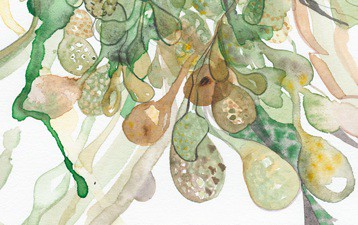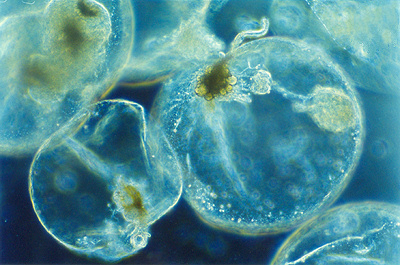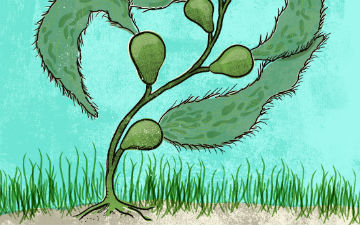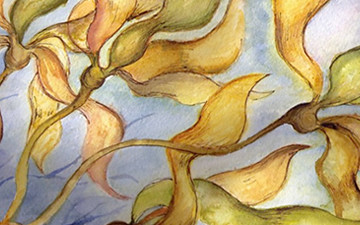Chromalveolata

Brown macroalgae
Sargassum spp.


Sorry, there is no photo available. If you have one, please submit
here
.
3 POINTS
• Sargassum spp. is an ALGAE and PLANKTON SPECIES.
cool, warm
Graphic by Emilie Clarkwww.emilieclark.com
Sargassum is a genus of brown (class Phaeophyceae) macroaldga (seaweed) in the order Fucales. Numerous species are distributed throughout the temperate and tropical oceans of the world, where they generally inhabit shallow water and coral reefs. However, the genus may be best known for its planktonic (free-floating) species. While most species within the class Phaeophyceae are predominantly cold […] read more

Sea Sparkle
Noctiluca scintillans



5 POINTS
Play: The bioluminescence Noctiluca scintillans is a PLANKTON that feeds off of other PLANKTON SPECIES.
Play: It must be played adjacent to at least 1 compatible PLANKTON SPECIES.
cool, warm
Graphic by Joe Klocjoekloc.com
Noctiluca scintillans, commonly known as the Sea Sparkle[1], and also published as Noctiluca miliaris, is a free-living non-parasitic marine-dwelling species of dinoflagellate that exhibits bioluminescence. The bioluminescent characteristic of N. scintillans is produced by a luciferin-luciferase system located in thousands of spherically shaped organelles, or “microsources”, located throughout the cytoplasm of this single-celled protist. Nonluminescent populations within the genus Noctiluca lack these microsources. N. scintillans […] read more

Giant Kelp
Macrocystis pyrifera


Sorry, there is no photo available. If you have one, please submit
here
.
3 POINTS
Fact: Macrocystis pyrifera is one of the fastest-growing organisms on Earth, growing more than 60 centimetres per day
cool, warm
Graphic by Lindsay Chetekwww.lindsaychetek.com/
Giant kelp Macrocystis pyrifera Scientific classification Kingdom: Chromalveolata Division: Heterokontophyta Class: Phaeophyceae Order: Laminariales Family: Laminariaceae Genus: Macrocystis Species: M. pyrifera Binomial name Macrocsytis pyrifera (L.) C.Ag.[1] Synonyms Fucus pyrifer L. Laminaria pyrifera (L.) Lamouroux M. humboldtii (Bonpland) C.Ag. M. planicaulis C. Agardh M. pyrifera var. humboldtii Bonplan. Macrocystis pyrifera, commonly known as Giant kelp […] read more

Phytoplankton
Class: Bacillariophyceae


Sorry, there is no photo available. If you have one, please submit
here
.
1 POINT
Play: Symbiodinium spp has a MOVE of 1, and is often eaten by KRILL SPECIES.
Fact: Symbiodinium spp are also crucially dependent on minerals
cold, cool, warm
Graphic by Kyu Hwangkyuhwang.com/
Phytoplankton (English pronunciation: /ˌfaɪtoʊˈplæŋktən/) are the autotrophic component of the plankton community. The name comes from the Greek words φυτόν (phyton), meaning “plant“, and πλαγκτός (planktos), meaning “wanderer” or “drifter”.[1] Most phytoplankton are too small to be individually seen with the unaided eye. However, when present in high enough numbers, they may appear as a […] read more

Bull Kelp
Nereocystis luetkeana


Sorry, there is no photo available. If you have one, please submit
here
.
5 POINTS
• Nereocystis luetkeana has a SPREAD of 1. Nereocystis luetkeana most likely gets its common name from its similarity to a bull-whip.
Cool, Warm
Graphic by Coral Cargillbluecnidaria.deviantart.com/
Nereocystis (Greek for “mermaid’s bladder”) is a genus of kelp. It forms thick beds on rocks, and is an important part of kelp forests. There is only one species, Nereocystis luetkeana. It can grow to a maximum of 74 meters. Nereocystis has aholdfast of about 40 centimeters, and a single stipe, topped with a pneumatocyst containing carbon monoxide, from which sprout […] read more